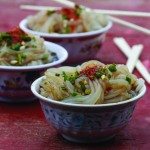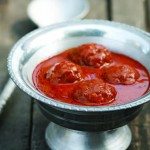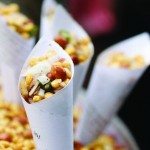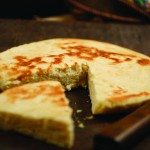6892 people saw it on FB
Swati Bhattacharya, Tejinder Singh and 83 others like this on the Lassi with Lavina FB page.
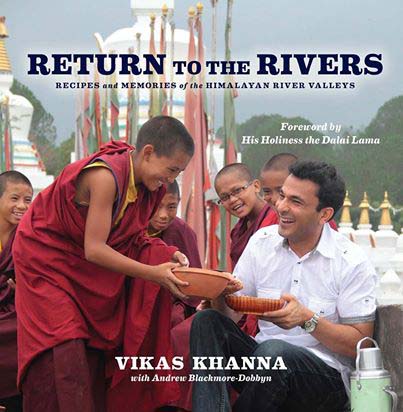
Vikas Khanna: Return to the Rivers
Vikas Khanna has scaled new gastronomic heights with his latest cookbook, ‘Return to the Rivers – Recipes and memories of the Himalayan River Valleys’, written with Andrew Blackmore-Dobbyn. This is a wonderful read not only for passionate cooks but also for those newbie chefs whose idea of cooking is heating up the remains of last night’s takeout. The stories will draw you into the kitchen…
In ‘Return to the Rivers’ (Lake Isle Press) you follow the meandering path of rivers in the Himalayan valleys and travel to quite a different part of India and its neighboring countries. Vikas Khanna, chef of the Michelin-starred Junoon Restaurant in NYC and the host of TV show ‘MasterChef India’, travels to rarely seen parts of India and Tibet, Nepal, and Bhutan to bring you local dishes and new tastes for your palate.
That the book is more than just a compilation of recipes is a pattern set by the foreword to the book by none other than His Holiness the Dalai Lama who writes ‘The culture, cuisines, and spiritual foundations of the Himalayan people are as deeply rooted as the skies in this region are soaring in their reach and grandeur.” It is the stories of these little-known and down-to-earth people that Vikas Khanna explores, sharing insights with readers about their way of life, their culture and the food that nourishes them. The personal stories and the excellent photographs make this a satisfying culinary journey.
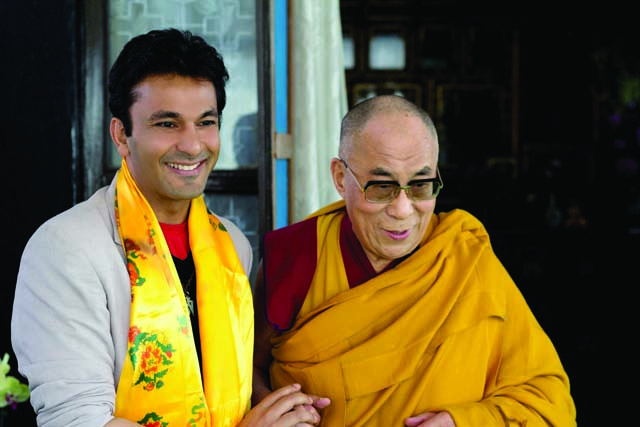
People, Community, Breaking Bread Together
The images have captured the everyday life of people from Tibet to Nepal to Bhutan to India, and the joy of small markets, kids at play, religious festivals, and families sharing a meal. I particularly enjoyed the images of something so plain and quintessential as bread – in cuisine even simple fare can be complex as you realize that each area has its own kind of bread, and each is special in its own way. You get to see a whole variety of breads and hear the stories behind them – Lhasa Crispy Bread (Yoshang Paley), the curious looking Tingmo or Tibetan Steamed Lotus Bread, Dalai Lama’s favorite bread Amdo Paley, Bhutanese buckwheat bread (Kepta), Kashmiri naans, and the Bodnath Temple Fried Bread (Ajwaini Poori), to name just a few.
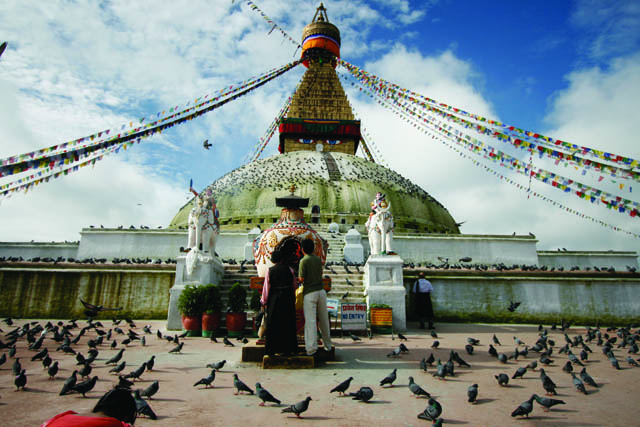
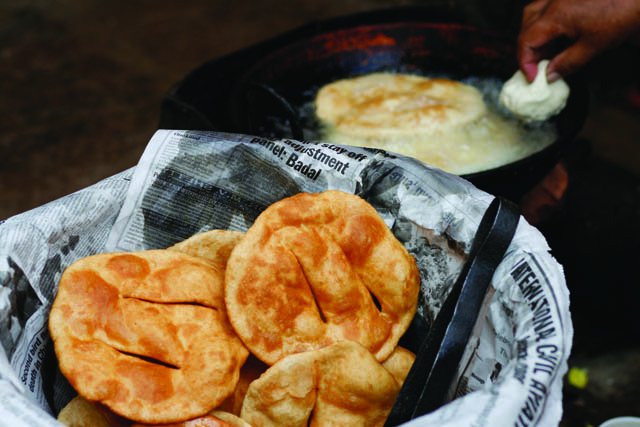
You learn interesting details such as the fact that Tibetans put aside vegetables for preserving so that they can have them during the cold of winter when little grows; except for Nepal, few of the mountain areas have pasture lands for animals, so that yak meat is often the easily obtained meat in the mountain areas – Vikas Khanna has replaced yak in those traditional recipes with lamb.
In these Himalayan encounters he also came across many local spices and he introduces us to Thingay or Szechuan peppercorns, Jimbu – a herb used in Nepali cooking, and Himalayan Pink Salt. He says that turmeric, which is used so commonly in Indian cuisine, is regarded more as a medicine in Tibet and can only be purchased from natural remedy pharmacies.
The book is divided into several categories with soups and noodles, grain, fish, vegetables, meats, desserts and beverages. One rather fun section is street foods, and goes to show that people in all these countries have a weakness for the spice and punch of these wayside snacks. A tip from Vikas Khanna: “It pays to wait and see who is doing the most business. If a vendor has a line, there’s probably a good reason for it, and you should head in that direction.”
The recipes include some quick tongue-pleasers such as split chickpea chaat, Durbar Square Chaat Piti, and Chana Daal and Peanut Chaat which are all easy to whip up while sitting in your NYC apartment! Others are more unusual and bring different cultures to your doorstep such as Hazratbal Lotus Root Fritters available at the Hazratbal Shrine in Srinagar during the holy month of Ramadan.
Momos, the snack food which is popular from Tibet to Nepal to India, is given an extensive section in the book with recipes and various filings. There are also intriguing recipes for noodles and soups from these Himalayan regions. Writes Vikas Khanna: “As with everything in the Himalayas, fuel is expensive and the fire that cooks foods must also heat the house, so frugality is important. Where possible, everything goes into the same pot. On a cold day, these soups will warm and energize you.”
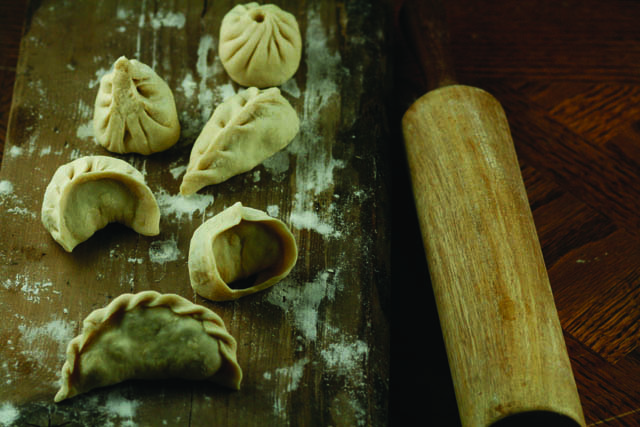
Dhal Bhaat to Wazwan Feasts
Simplicity and down-to-flavor are the keywords here, be it Tibetan-style Lo Mein (Thukpa Dangmo) or Mrs. Shreshta’s Red Lentil Soup. There’s also the intriguingly named Sikkim Nettle Soup (Sishnu) which actually contain two cups of wild edible nettles found in Sikkim. A word of caution from the chef: “Nettles sting so wear gloves while handling the leaves.”
Vikas Khanna introduces you to traditional dishes such as Dhal Bhaat, the Nepalese national dish of lentils and rice, Ema Datshi, the Bhutanese national dish of cheese and chiles, and Wazwan Rishta, part of the traditional Wazwan feast in Kashmir. While meat is such an important part of the diet of people in these Himalayan areas, there are interesting vegetarian dishes too such as Sikkimese Turmeric and Ginger Potatoes. This simple dish has many health benefits and is easy to prepare.
At the same time there are dishes which have evolved due to the exodus of people and the creation of diasporas. The Dharamshala Peas and Carrots is one such dish that is the result of migration. As Vikas Khanna writes in the book, “Whatever its origins, it reminds me that I am grateful for the presence of Tibetans in India. They have enriched our spiritual lives immeasurably with their constant mindfulness of life’s many blessings.”
Vikas Khanna: In His Own Words…
There are stories behind even the naming of original dishes such as the Viku-Niku Chicken and make for pleasurable reading. Many of the recipes will be a first-time experience for readers such as Chicken-Wrapped Chiles or Tibetan Walnut Fudge. Also, there are marriages between cultures: Vikas Khanna says the Indian yogurt drink lassi is becoming common amongst the Tibetan exile community, while in Tibet a similar drink is Tara. He creates a mix of the two drinks – a hybrid lassi-tara blend.
The threads of religion, spirituality and festivals run through many of the recipes for these are all very vital to community life in these regions. If you can’t get to the great pilgrimage spot of Vaishno Devi, you can at least try to recreate the Vaisno Devi Chickpeas Masala.
Through its photographs and its diverse recipes of the cuisines of these Himalayan regions, Vikas Khanna, ever the story-teller, takes us on an armchair trip to areas where we may never venture. He introduces us to a gentle people and a simple way of life where family and festivals, hard work and friendships are paramount, and where sometimes time seems to stand perfectly still…
Enjoy experimenting with some of the recipes in this related piece:Recipes from Return to the Rivers

